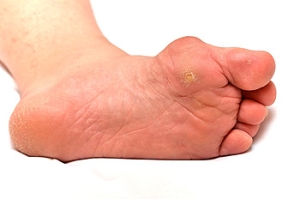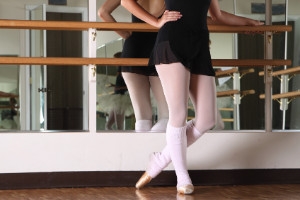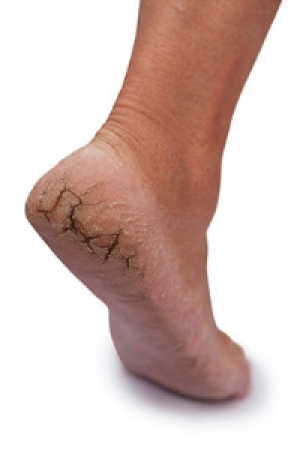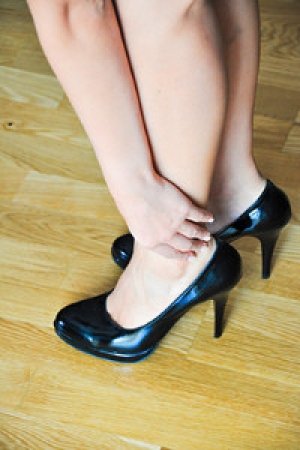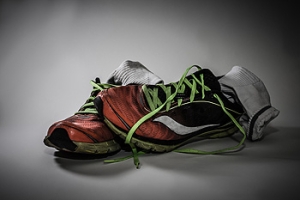(410) 764-7044
6506 Reisterstown Road, Baltimore
1205 York Road, Lutherville
6305 Belair Road, Baltimore
7809 Wise Avenue, Dundalk

Sever's Disease
Sever’s disease, also known as calcaneal apophysitis is a common bone disorder that occurs during childhood. The disease is defined as an inflammation of the growth plate in the heel. When a child has a growth spurt, his heel bone grows faster than the muscles, tendons, and ligaments in his leg. This disease is a result of overuse. The people who are most likely to be affected by this disease are children who are in a growth spurt, especially boys who are from the ages of 5 to 13 years old. 60% of children with Sever’s disease have both heels involved.
Symptoms of this disease are heel pain that intensifies during running and jumping activities. The pain is typically localized to the posterior part of the heel. Symptoms may be severe, and they can easily interfere with daily activities. Children who play soccer, baseball, and basketball are more likely to develop Sever’s disease.
Your doctor will diagnose your child based on his or her symptoms, x-rays are generally not helpful in diagnosing this disease. Your doctor may examine both heels and ask your child questions about his or her activity level in sports. Your doctor may then use the squeeze test on your child’s heel to see if there is any pain. Nevertheless, some doctors might still use x-rays to rule out any other issues such as fractures, infections, and tumors.
Sever’s disease can be prevented by maintaining good flexibility while your child is growing. Another prevention method is to wear good-quality shoes that have firm support and a shock-absorbent sole. Sever’s disease can be treated by ceasing any activity that causes heel pain. You should apply ice to the injured heel for 20 minutes 3 times a day. Additionally, orthotics should be used for children who have high arches, flat feet, or bowed legs.
If you suspect your child has Sever’s disease, you should make an appointment with your podiatrist to have his or her foot examined. Your doctor may recommend nonsteroidal anti-inflammatory drugs (NSAIDs), such as ibuprofen or naproxen to relieve pain. In more severe cases, your child may need a cast to rest his or her heel. Fortunately, Sever’s disease does not cause long-term foot problems. After treatment, your child should start to feel better within two weeks to two months.
Possible Causes of Bunions
 The foot condition that is known as a bunion may develop as the aging process occurs. It is one of the more common foot ailments and may often affect women more than men. It appears as a bony protrusion on the side of the big toe and may cause considerable pain and discomfort. There may be foot issues that can develop as a result of having a bunion, and these may include nerve damage that is incurred on the big toe in which feeling may be lost, calluses may develop on the sole of the foot, in addition to the toe appearing red and swollen. There may be several reasons why bunions may form, and these may include wearing shoes with limited room for the toes to move freely in, a genetic disposition, or medical conditions such as rheumatoid arthritis. If you notice a bunion that is forming, it is advised to seek the counsel of a podiatrist who can discuss correct treatment options, which may include surgery.
The foot condition that is known as a bunion may develop as the aging process occurs. It is one of the more common foot ailments and may often affect women more than men. It appears as a bony protrusion on the side of the big toe and may cause considerable pain and discomfort. There may be foot issues that can develop as a result of having a bunion, and these may include nerve damage that is incurred on the big toe in which feeling may be lost, calluses may develop on the sole of the foot, in addition to the toe appearing red and swollen. There may be several reasons why bunions may form, and these may include wearing shoes with limited room for the toes to move freely in, a genetic disposition, or medical conditions such as rheumatoid arthritis. If you notice a bunion that is forming, it is advised to seek the counsel of a podiatrist who can discuss correct treatment options, which may include surgery.
If you are suffering from bunion pain, contact one of our podiatrists of Plaza Podiatry. Our doctors can provide the care you need to keep you pain-free and on your feet.
What Is a Bunion?
Bunions are painful bony bumps that usually develop on the inside of the foot at the joint of the big toe. As the deformity increases over time, it may become painful to walk and wear shoes. Women are more likely to exacerbate existing bunions since they often wear tight, narrow shoes that shift their toes together. Bunion pain can be relieved by wearing wider shoes with enough room for the toes.
Causes
- Genetics – some people inherit feet that are more prone to bunion development
- Inflammatory Conditions - rheumatoid arthritis and polio may cause bunion development
Symptoms
- Redness and inflammation
- Pain and tenderness
- Callus or corns on the bump
- Restricted motion in the big toe
In order to diagnose your bunion, your podiatrist may ask about your medical history, symptoms, and general health. Your doctor might also order an x-ray to take a closer look at your feet. Nonsurgical treatment options include orthotics, padding, icing, changes in footwear, and medication. If nonsurgical treatments don’t alleviate your bunion pain, surgery may be necessary.
If you have any questions, please feel free to contact our offices located in Baltimore, Lutherville, and Dundalk, MD . We offer the newest diagnostic and treatment technologies for all your foot care needs.
Bunions
A bunion is a bump that forms at the base of the big toe. Bunions form when the big toe pushes against the next toe, which forces the big toe joint to get bigger and stick out. As a result, the skin over the bunion may start to appear red and it may feel sore.
There are risk factors that can increase your chances of developing bunions. People who wear high heels or ill-fitting shoes are more likely to develop them, in addition to those who have a genetic history of bunions or have rheumatoid arthritis.
The most obvious way to tell if you have a bunion is to look for the big toe pushing up against the toe next to it. Bunions produce a large protrusion at the base of the big toe and may or may not cause pain. Other symptoms are redness, swelling, and restricted movement of the big toe if you have arthritis.
Nonsurgical methods are frequently used to treat bunions that aren’t severe. Some methods of nonsurgical treatment are orthotics, icing and resting the foot, taping the foot, and pain medication. Surgery is usually only required in extreme cases. However, if surgery is needed, some procedures may involve removing the swollen tissue from around the big toe joint, straightening the big toe by removing part of the bone, or joining the bones of your affected joint permanently.
Your podiatrist will diagnose your bunion by doing a thorough examination of your foot. He or she may also conduct an x-ray to determine the cause of the bunion and its severity.
Ballet Shoes and Blisters
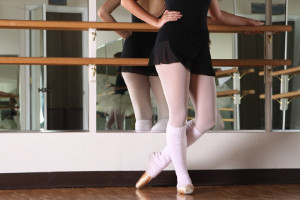 Ballet dancers may often experience painful and uncomfortable blisters, which may be a result of the type of ballet shoes that are worn. Most blisters develop because a portion of the skin rubs on the shoe, and this may cause friction to occur. It’s important to find a pointed shoe that fits perfectly, and this is often accomplished with the help of trained professionals. Research has shown it may be helpful to sprinkle powder inside the shoes, and this may aid in absorbing excess moisture, which may help in the prevention of blisters. If a blister has developed, and ballet dancing must continue, it is imperative to determine if the liquid inside the blister is clear. This must precede any lancing technique, followed by utilizing an antibiotic ointment, which may aid in preventing an infection. If you are frequently developing blisters that need treatment, it is advised to consult with a podiatrist who can properly assist you.
Ballet dancers may often experience painful and uncomfortable blisters, which may be a result of the type of ballet shoes that are worn. Most blisters develop because a portion of the skin rubs on the shoe, and this may cause friction to occur. It’s important to find a pointed shoe that fits perfectly, and this is often accomplished with the help of trained professionals. Research has shown it may be helpful to sprinkle powder inside the shoes, and this may aid in absorbing excess moisture, which may help in the prevention of blisters. If a blister has developed, and ballet dancing must continue, it is imperative to determine if the liquid inside the blister is clear. This must precede any lancing technique, followed by utilizing an antibiotic ointment, which may aid in preventing an infection. If you are frequently developing blisters that need treatment, it is advised to consult with a podiatrist who can properly assist you.
Blisters may appear as a single bubble or in a cluster. They can cause a lot of pain and may be filled with pus, blood, or watery serum. If your feet are hurting, contact one of our podiatrists of Plaza Podiatry. Our doctors can provide the care you need to keep you pain-free and on your feet.
Foot Blisters
Foot blisters are often the result of friction. This happens due to the constant rubbing from shoes, which can lead to pain.
What Are Foot Blisters?
A foot blister is a small fluid-filled pocket that forms on the upper-most layer of the skin. Blisters are filled with clear fluid and can lead to blood drainage or pus if the area becomes infected.
Symptoms
(Blister symptoms may vary depending on what is causing them)
- Bubble of skin filled with fluid
- Redness
- Moderate to severe pain
- Itching
Prevention & Treatment
In order to prevent blisters, you should be sure to wear comfortable shoes with socks that cushion your feet and absorb sweat. Breaking a blister open may increase your chances of developing an infection. However, if your blister breaks, you should wash the area with soap and water immediately and then apply a bandage to the affected area. If your blisters cause severe pain it is important that you call your podiatrist right away.
If you have any questions, please feel free to contact our offices located in Baltimore, Lutherville, and Dundalk, MD . We offer the newest diagnostic and treatment technologies for all your foot care needs.
Blisters
Blisters are pockets of fluid that occur under the top layer of your skin. These fluid pockets are usually filled with pus, blood, or serum. Blisters may itch or hurt and can appear as a single bubble or in clusters.
The most common types of blisters are friction blisters. This type of blister may be caused by wearing shoes that are too tight. Friction blisters can also occur on the hands. A change in temperature may also cause blisters on the feet. In the freezing air, frostbite on your toes can lead to blisters, as well as sunburn from hot weather.
The best way to treat a blister is to keep it clean and dry. Most blisters will get better on their own. Once the skin absorbs the fluid within the blister, it will flatten and eventually peel off. You should avoid popping your blister unless you podiatrist does it for you. Additional treatment options include applying an ice pack to the blister or using over-the-counter blister bandages to cover the affected area.
If your blister becomes discolored, inflamed, or worsens it is advised that you speak to your podiatrist. Blisters that are yellow, green, or purple may be infected and require immediate medical attention. Blisters that are abnormally colored may be a sign of a more serious underlying health condition such as herpes.
Can Cracked Heels Be Prevented?
 Many people who enjoy walking barefoot or wearing flip-flops during the summer months may be surprised to learn that there may be consequences that can follow as a result of this. The skin may become dry, calluses may possibly form, and fissures in the skin of the heels, known as cracked heels, may develop. If the cracks in the skin should bleed, severe pain, discomfort, and infection may accompany this condition. There may be remedies that can be practiced to prevent and relieve extremely dry skin, and these may include washing and drying the feet thoroughly followed by utilizing a good moisturizer. At this point, it is suggested to wear socks while sleeping for the night, and this may aid in healing painful fissures. If you would like additional information about how to treat cracked heels, it is advised to consult with a podiatrist who can discuss the best options for you.
Many people who enjoy walking barefoot or wearing flip-flops during the summer months may be surprised to learn that there may be consequences that can follow as a result of this. The skin may become dry, calluses may possibly form, and fissures in the skin of the heels, known as cracked heels, may develop. If the cracks in the skin should bleed, severe pain, discomfort, and infection may accompany this condition. There may be remedies that can be practiced to prevent and relieve extremely dry skin, and these may include washing and drying the feet thoroughly followed by utilizing a good moisturizer. At this point, it is suggested to wear socks while sleeping for the night, and this may aid in healing painful fissures. If you would like additional information about how to treat cracked heels, it is advised to consult with a podiatrist who can discuss the best options for you.
If the skin on your feet starts to crack, you may want to see a podiatrist to find treatment. If you have any concerns, contact one of our podiatrists from Plaza Podiatry. Our doctors can provide the care you need to keep you pain-free and on your feet.
Cracked Heels
It is important to moisturize your cracked heels in order to prevent pain, bleeding, and infection. The reason cracked heels form is because the skin on the foot is too dry to support the immense pressure placed on them. When the foot expands, the dry skin on the foot begins to split.
Ways to Help Heal Them
- Invest in a good foot cream
- Try Using Petroleum Jelly
- Ease up on Soaps
- Drink Plenty of Water
Ways to Prevent Cracked Heels
- Moisturize After Showering
- Skip a Shower
- Keep Shower Water Lukewarm
- Don’t Scrub Your Feet
If you are unsure how to proceed in treating cracked heels, seek guidance from a podiatrist. Your doctor will help you with any questions or information you may need.
If you have any questions, please feel free to contact our offices located in Baltimore, Lutherville, and Dundalk, MD . We offer the newest diagnostic and treatment technologies for all your foot care needs.
Solutions for Cracked Heels
Cracked heels may make you want to think twice about showing off your feet in warmer weather. However, cracked heels may be harmful to more than just the appearance of your feet. If deep fissures and cracks develop in your heels, they may make walking and standing painful for you. Additionally, these openings make way for germs to enter through your skin and cause infection.
There are several different causes of cracked heels. One of the most common reasons for this ailment is dry skin. This problem may make your keeps feel rough tight and itchy. Dry skin may be caused by cold air, extremely hot water, harsh soaps, and aging. Skin disorders such as eczema and psoriasis may eventually lead to dry skin. In some cases, complications may arise from cracked heels. Some of these complications are a loss of feeling in the heel, cellulitis, or a diabetic foot ulcer.
There are ways you can try to prevent getting cracked heels. One of the best ways to do so is to avoid wearing flip flops and sandals because these shoes increase your risk of drying out your feet. You should also avoid wearing shoes with a tall skinny heel, because these shoes cause your heel to expand sideways. At night, you should slather on a thick moisturizing cream on your feet and then cover them in socks to keep your feet moisturized overnight. Drinking water to stay hydrated is also a good way to ensure that your skin doesn’t become dry.
If you suffer from a severe case of cracked feet, you should make an appointment with your podiatrist to see what treatment methods are best for you.
Wearing High Heels May Affect the Ankles
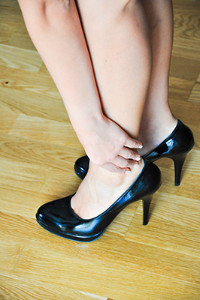 Even though many women enjoy wearing high heels and admire how the foot looks in high heeled shoes, there may be specific foot issues that may develop as a result of wearing this type of shoe. The ankles may become unstable, which may affect the body’s balance, in addition to providing inadequate support while walking. Research has shown that muscles may gradually reduce in length in the back of the leg and they may get longer in the front of the leg. These changes may affect the muscle strength in the leg and may influence overall body stability. If you choose to wear high heels, there may be techniques that can be implemented, which may minimize any injuries that may occur. These may include performing gentle stretching exercises, using resistance bands that may aid in strengthening the leg muscles, and using your toes to pick up small objects, which may help the muscles in the toes to become stronger. If you have questions about the effects high heels can have on your feet, it is suggested to speak with a podiatrist.
Even though many women enjoy wearing high heels and admire how the foot looks in high heeled shoes, there may be specific foot issues that may develop as a result of wearing this type of shoe. The ankles may become unstable, which may affect the body’s balance, in addition to providing inadequate support while walking. Research has shown that muscles may gradually reduce in length in the back of the leg and they may get longer in the front of the leg. These changes may affect the muscle strength in the leg and may influence overall body stability. If you choose to wear high heels, there may be techniques that can be implemented, which may minimize any injuries that may occur. These may include performing gentle stretching exercises, using resistance bands that may aid in strengthening the leg muscles, and using your toes to pick up small objects, which may help the muscles in the toes to become stronger. If you have questions about the effects high heels can have on your feet, it is suggested to speak with a podiatrist.
High heels have a history of causing foot and ankle problems. If you have any concerns about your feet or ankles, contact one of our podiatrists from Plaza Podiatry. Our doctors can provide the care you need to keep you pain-free and on your feet.
Effects of High Heels on the Feet
High heels are popular shoes among women because of their many styles and societal appeal. Despite this, high heels can still cause many health problems if worn too frequently.
Which Parts of My Body Will Be Affected by High Heels?
- Ankle Joints
- Achilles Tendon – May shorten and stiffen with prolonged wear
- Balls of the Feet
- Knees – Heels cause the knees to bend constantly, creating stress on them
- Back – They decrease the spine’s ability to absorb shock, which may lead to back pain. The vertebrae of the lower back may compress.
What Kinds of Foot Problems Can Develop from Wearing High Heels?
- Corns
- Calluses
- Hammertoe
- Bunions
- Morton’s Neuroma
- Plantar Fasciitis
How Can I Still Wear High Heels and Maintain Foot Health?
If you want to wear high heeled shoes, make sure that you are not wearing them every day, as this will help prevent long term physical problems. Try wearing thicker heels as opposed to stilettos to distribute weight more evenly across the feet. Always make sure you are wearing the proper shoes for the right occasion, such as sneakers for exercising. If you walk to work, try carrying your heels with you and changing into them once you arrive at work. Adding inserts to your heels can help cushion your feet and absorb shock. Full foot inserts or metatarsal pads are available.
If you have any questions please feel free to contact our offices located in Baltimore, Lutherville, and Dundalk, MD . We offer the newest diagnostic and treatment technologies for all your foot and ankle needs.
Effect of High Heels on the Feet
High heels are uncomfortable, but many women sacrifice comfort to be stylish. There are many problems that stem from wearing high heels, however these issues can be avoided by wearing proper shoes.
Heels are bad because they push your weight forward toward the fall of the foot. The higher the heel is, the more weight and pressure get shifted. This process causes the back to hyperextend backwards to counterbalance which may cause pain in the leg, hip, and back. Consequently, major posture problems may occur, and these issues may eventually become permanent.
Wearing high heels is one of the leading cause of ingrown toenails. Heels create a great deal of pressure on the big toenails which disrupts proper toenail growth. This may eventually lead to the big toenail growing into the skin. Another common problem that stems from high heels is bunions. If bunions go untreated, they can cause serious scar tissue to form along with severe pain.
However, there are ways to minimize the harmful risks associated with wearing heels. You should try to massage and stretch your legs and feet after wearing heels for an extended time. Stretching helps prevent the Achilles tendons and calf muscles from becoming too tight. A good substitute for heels are platforms which provide a better surface area to evenly distribute the body’s weight.
If you are experiencing any painful foot conditions from wearing high heels, you should consult with your podiatrist right away.
What Are the Benefits of Wearing Cycling Shoes?
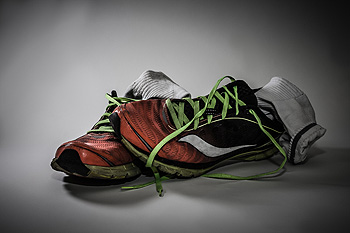 People who enjoy the sport of cycling may understand the importance of wearing proper shoes while biking. These specific shoes are designed to attach to the pedals by cleats that are located on the bottom of the shoe, which may allow foot pain to be avoided. This improved method may prevent the shoes from slipping while pedaling, which may possibly result in more efficient use of the foot muscles. Research has shown that the late afternoon may be a beneficial time in choosing the correct shoe, when the feet are generally at their largest. Most shoes that are worn for cycling will stretch minimally over the course of time, and it is advised that they fit properly at the time of purchase. If you would like to have additional information about the benefits of wearing cycling shoes, please speak with a podiatrist.
People who enjoy the sport of cycling may understand the importance of wearing proper shoes while biking. These specific shoes are designed to attach to the pedals by cleats that are located on the bottom of the shoe, which may allow foot pain to be avoided. This improved method may prevent the shoes from slipping while pedaling, which may possibly result in more efficient use of the foot muscles. Research has shown that the late afternoon may be a beneficial time in choosing the correct shoe, when the feet are generally at their largest. Most shoes that are worn for cycling will stretch minimally over the course of time, and it is advised that they fit properly at the time of purchase. If you would like to have additional information about the benefits of wearing cycling shoes, please speak with a podiatrist.
Finding a properly-fitting shoe is important in reducing injuries and preventing foot problems. For more information about treatment, contact one of our podiatrists from Plaza Podiatry. Our doctors will treat your foot and ankle needs.
Proper Shoe Fitting
A common concern when it comes to foot health, having properly fitted shoes can help prevent injuries to the foot. Out feet affect our posture and gait, which in turn affects the biomechanics and overall bodily structure. With 33 joints, 26 bones, and over 100 ligaments, the potential for serious injury is much greater than one realizes. Although the feet cease growth in adulthood, they still change shape as they mature. Here are some factors to consider when it comes to investing in proper fitting shoes:
- Be sure the shoes fit correctly right away
- Ensure the ball of your foot fits comfortably in the widest portion of the shoes
- Even though they may look fashionable, improper fitting shoes can either create adverse conditions or exacerbate existing ones you may already have
- Walk along a carpeted surface to ensure the shoes comfortably fit during normal activity
Keeping in mind how shoes fit the biomechanics of your body, properly-fitting shoes are vitally important. Fortunately, it is not difficult to acquire footwear that fits correctly. Be sure to wear shoes that support the overall structure of your body. Do your feet a favor and invest in several pairs of well-fitted shoes today.
If you have any questions please feel free to contact our offices located in Baltimore, Lutherville, and Dundalk, MD . We offer the newest diagnostic and treatment technologies for all your foot and ankle needs.

